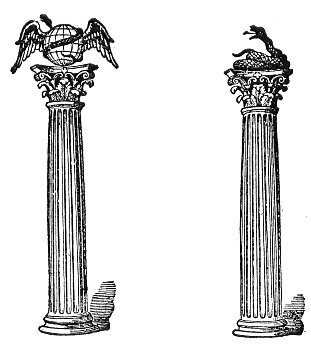The Sun was figuratively said to die and be born again at the Winter Solstice; the games of the Circus, in honor of the invincible God-Sun, were then celebrated, and the Roman year, established
p. 465
or reformed by Numa, commenced. Many peoples of Italy commenced their year, Macrobius says, at that time; and represented by the four ages of man the gradual succession of periodical increase and diminution of day, and the light of the Sun; likening him to an infant born at the Winter Solstice, a young man at the Vernal Equinox, a robust man at the Summer Solstice, and an old man at the Autumnal Equinox.
This idea was borrowed from the Egyptians, who adored the Sun at the Winter Solstice, under the figure of an infant.
The image of the Sign in which each of the four seasons commenced, became the form under which was figured the Sun of that particular season. The Lion’s skin was worn by Hercules; the horns of the Bull adorned the forehead of Bacchus; and the autumnal serpent wound its long folds round the Statue of Serapis, 2500 years before our era; when those Signs corresponded with the commencement of the Seasons. When other constellations replaced them at those points, by means of the precession of the Equinoxes, those attributes were changed. Then the Ram furnished the horns for the head of the Sun, under the name of Jupiter Ammon. He was no longer born exposed to the waters of Aquarius, like Bacchus, nor enclosed in an urn like the God Canopus; but in the Stables of Augeas or the Celestial Goat. He then completed his triumph, mounted on an ass, in the constellation Cancer, which then occupied the Solstitial point of Summer.
Other attributes the images of the Sun borrowed from the constellations which, by their rising and setting, fixed the points of departure of the year, and the commencements of its four principal divisions.
First the Bull and afterward the Ram (called by the Persians the Lamb), was regarded as the regenerator of Nature, through his union with the Sun. Each, in his turn, was an emblem of the Sun overcoming the winter darkness, and repairing the disorders of Nature, which every year was regenerated under these Signs, after the Scorpion and Serpent of Autumn had brought upon it barrenness, disaster, and darkness. Mithras was represented sitting on a Bull; and that animal was an image of Osiris: while the Greek Bacchus armed his front with its horns, and was pictured with its tail and feet.
The Constellations also became noteworthy to the husbandman, which by their rising or setting, at morning or evening, indicated
p. 466
the coming of this period of renewed fruitfulness and new life. Capella, or the kid Amalthea, whose horn is called that of abundance, and whose place is over the equinoctial point, or Taurus; and the Pleiades, that long indicated the Seasons, and gave rise to a multitude of poetic fables, were the most observed and most celebrated in antiquity.
The original Roman year commenced at the Vernal Equinox. July was formerly called Quintilis, the 5th month, and August Sextilis, the 6th, as September is still the 7th month, October the 8th, and so on. The Persians commenced their year at the same time, and celebrated their great feast of Neurouz when the Sun entered Aries and the Constellation Perseus rose,–Perseus, who first brought down to earth the heavenly fire consecrated in their temples: and all the ceremonies then practised reminded men of the renovation of Nature and the triumph of Ormuzd, the Light-God, over the powers of Darkness and Ahriman their Chief.
The Legislator of the Jews fixed the commencement of their year in the month Nisan, at the Vernal Equinox, at which season the Israelites marched out of Egypt and were relieved of their long bondage; in commemoration of which Exodus, they ate the Paschal Lamb at that Equinox. And when Bacchus and his army had long marched in burning deserts, they were led by a Lamb or Ram into beautiful meadows, and to the Springs that watered the Temple of Jupiter Ammon. For, to the Arabs and Ethiopians, whose great Divinity Bacchus was, nothing was so perfect a type of Elysium as a Country abounding in springs and rivulets.

Moe is the founder of GnosticWarrior.com. He is a father, husband, author, martial arts black belt, and an expert in Gnosticism, the occult, and esotericism.






